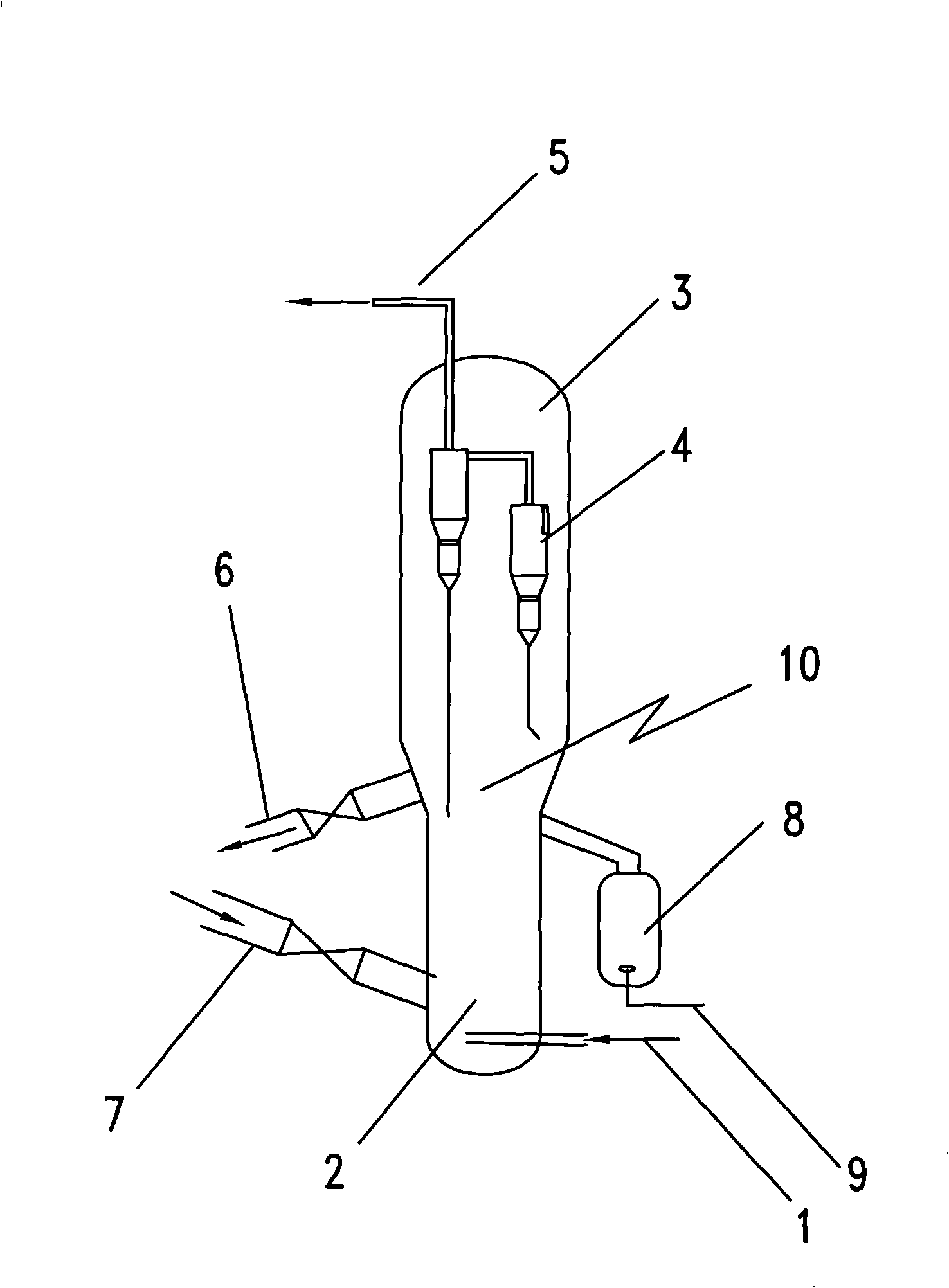Method for keeping regenerator temperature stable in low carbon alkene preparation
A low-carbon olefin and regenerator technology, which is applied in the direction of hydrocarbon production from oxygen-containing organic compounds, chemical recovery, organic chemistry, etc., can solve the problems of large temperature fluctuations in the regenerator, so as to avoid excessive dilute phase temperature and reduce O2 Concentration, the effect of reducing cold collapse
- Summary
- Abstract
- Description
- Claims
- Application Information
AI Technical Summary
Problems solved by technology
Method used
Image
Examples
Embodiment 1
[0017] exist figure 1 In the small-scale dense-phase fluidized bed regenerator shown, the catalyst is SAPO-34 molecular sieve, the amount of carbon deposited on the ungenerated catalyst belt is 4.5% by weight, the regeneration temperature is set at 650°C, the regeneration medium is air, and the air flow rate is 18 meters 3 / hour, the temperature of the regeneration medium is 180°C, the temperature of the regeneration dense phase and the flow rate of the fluidized medium of the external heat extractor of the regenerator adopt automatic cascade control, the external heat extractor of the regenerator is a back-mixing type, the fluidized medium is nitrogen, and the heat exchange The medium is water, the weight ratio of the CO combustion aid to the total amount of catalyst in the regenerator is about 1%, and the CO combustion aid is Pt / Al 2 o 3 , the running results for three consecutive hours show that: O in the generated flue gas 2 The content is always between 0.52% and 0.72%...
Embodiment 2
[0019] exist figure 1 In the shown small-scale dense-phase fluidized bed regenerator, the catalyst is SAPO-18 molecular sieve, the amount of coke deposited on the ungenerated catalyst belt is 7.5% by weight, the regeneration temperature is set at 700°C, the regeneration medium is air, and the air flow rate is 24 meters 3 / hour, the temperature of the regeneration medium is 300°C, the temperature of the regeneration dense phase and the flow rate of the fluidized medium of the external heat extractor of the regenerator adopt automatic cascade control, the external heat extractor of the regenerator is a back-mixing type, the fluidized medium is nitrogen, and the heat exchange The medium is water, the weight ratio of the CO combustion aid to the total amount of catalyst in the regenerator is about 1%, and the CO combustion aid is Pd / Al 2 o 3 , the running results for three consecutive hours show that: O in the generated flue gas 2 The content is always between 0.15 and 0.29% by...
Embodiment 3
[0021] exist figure 1 In the shown small-scale dense-phase fluidized bed regenerator, the catalyst is SAPO-34 molecular sieve, the amount of carbon deposited on the ungenerated catalyst belt is 0.5% by weight, the regeneration temperature is set at 600°C, the regeneration medium is air, and the air flow rate is 10 meters 3 / hour, the temperature of the regeneration medium is 100°C, the regeneration dense phase temperature and the flow rate of the fluidized medium of the external heat extractor of the regenerator adopt automatic cascade control, the external heat extractor of the regenerator is a back-mixing type, the fluidized medium is nitrogen, and the heat exchange The medium is water, the weight ratio of the CO combustion aid to the total amount of catalyst in the regenerator is about 1%, and the CO combustion aid is Pt / Al 2 o 3 , the running results for three consecutive hours show that: O in the generated flue gas 2The content is always between 0.48% and 0.83% by volu...
PUM
 Login to View More
Login to View More Abstract
Description
Claims
Application Information
 Login to View More
Login to View More - Generate Ideas
- Intellectual Property
- Life Sciences
- Materials
- Tech Scout
- Unparalleled Data Quality
- Higher Quality Content
- 60% Fewer Hallucinations
Browse by: Latest US Patents, China's latest patents, Technical Efficacy Thesaurus, Application Domain, Technology Topic, Popular Technical Reports.
© 2025 PatSnap. All rights reserved.Legal|Privacy policy|Modern Slavery Act Transparency Statement|Sitemap|About US| Contact US: help@patsnap.com

